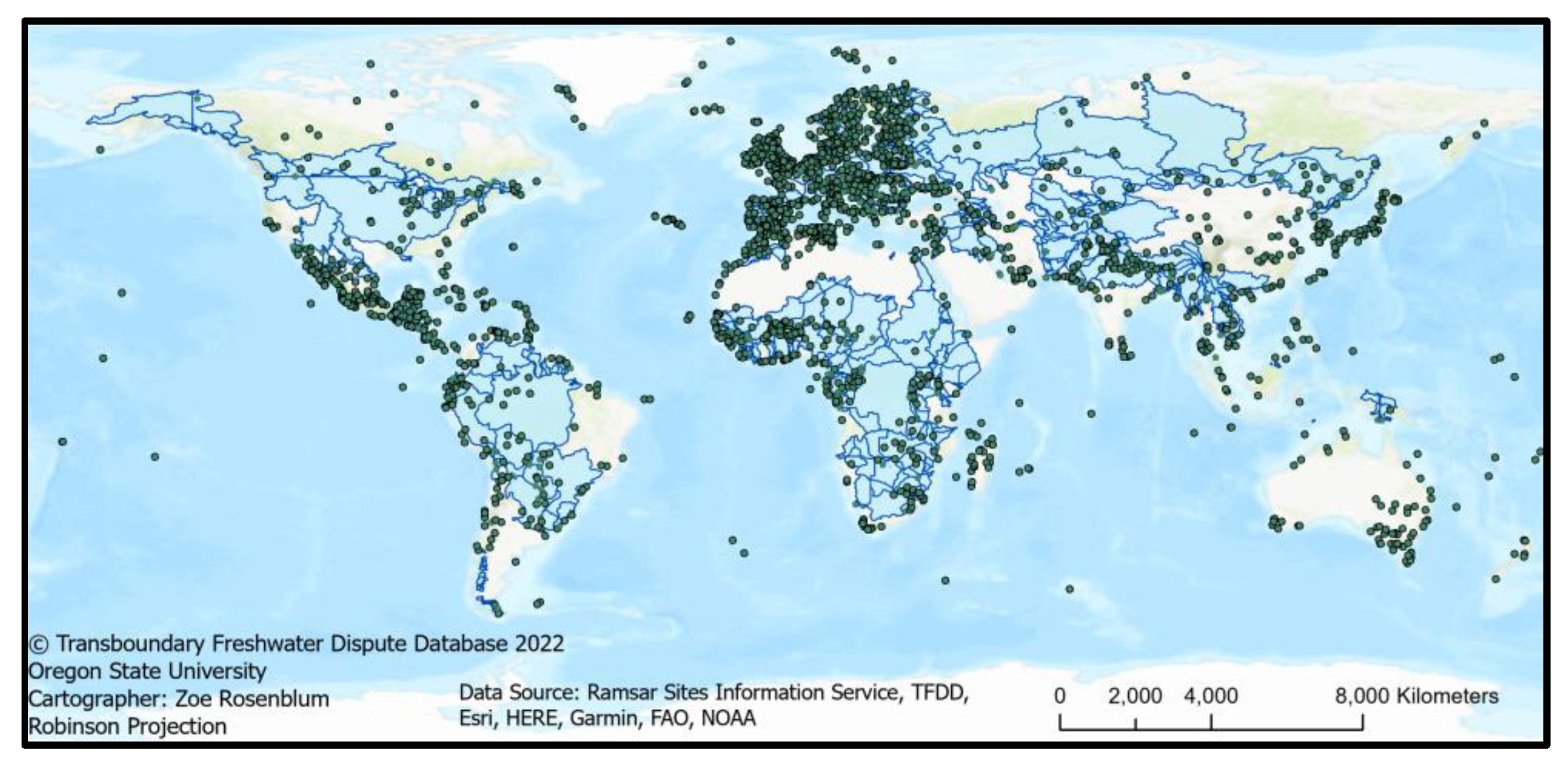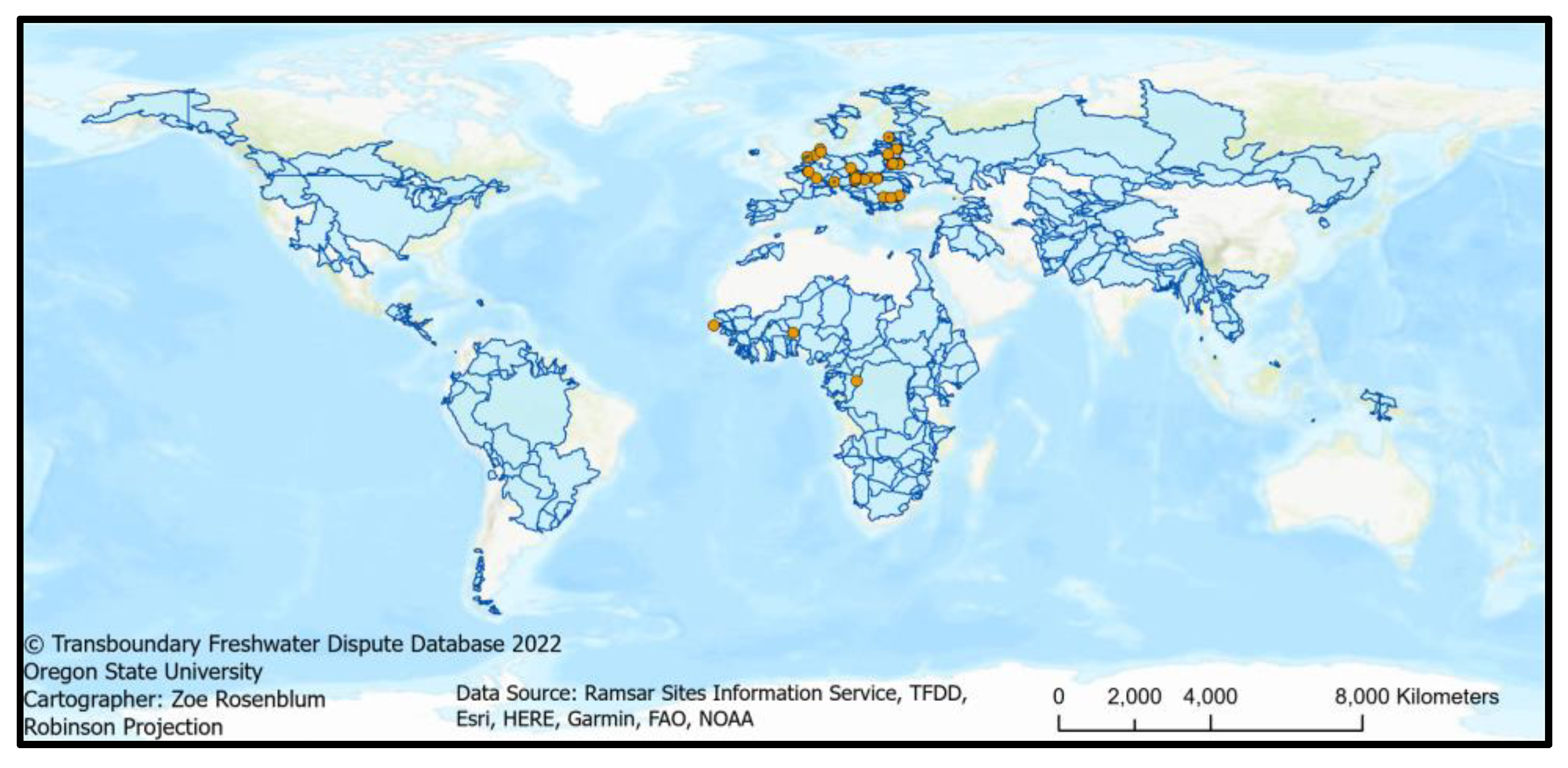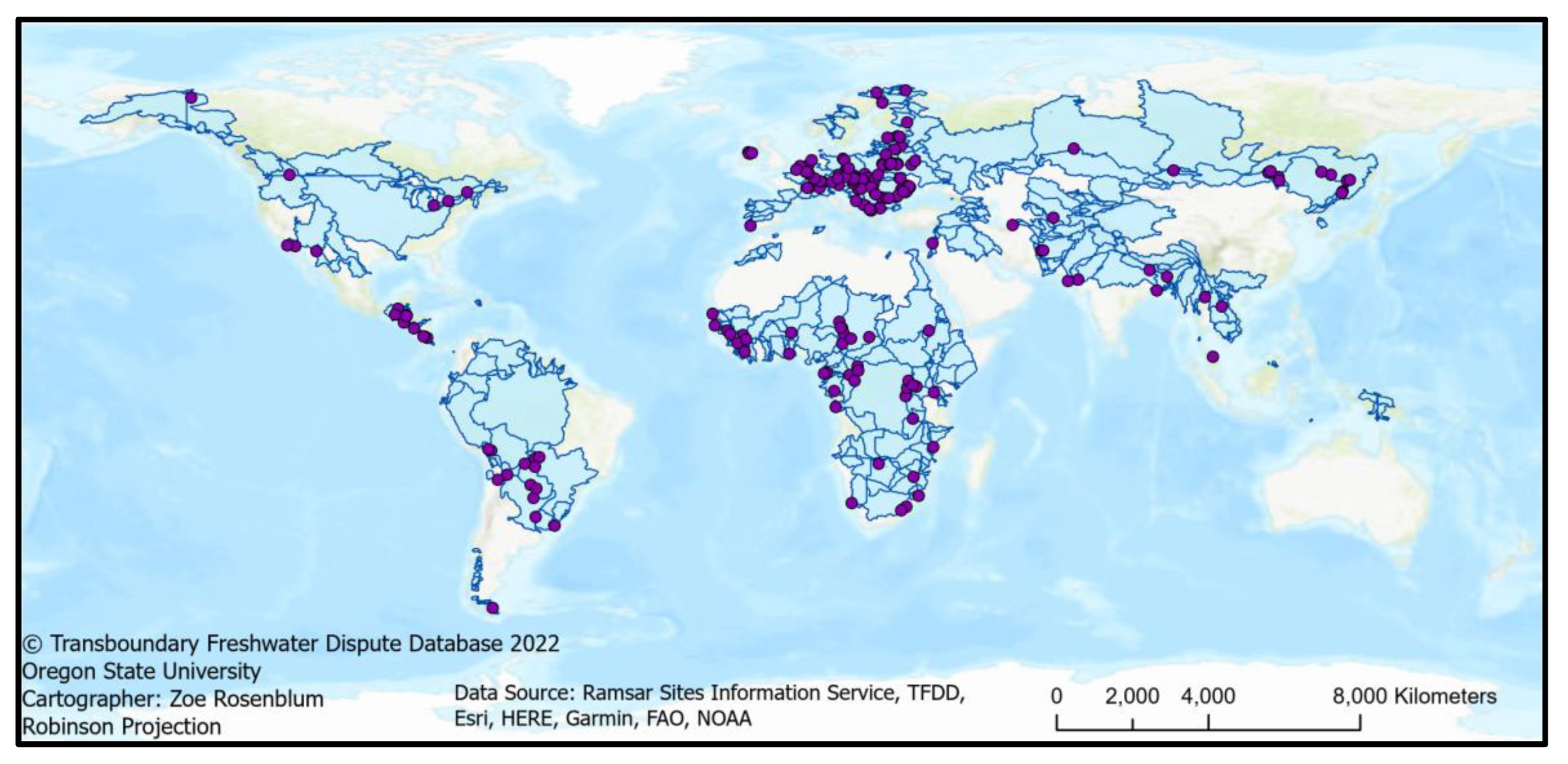Global Wetland Governance: Introducing the Transboundary Wetlands Database
Abstract
:1. Introduction
Transboundary Wetland Governance
2. Materials & Methods
3. Results
3.1. Documenting Transboundary Wetlands
3.2. Transboundary Wetlands in International River Basins
4. Discussion and Conclusions
Author Contributions
Funding
Institutional Review Board Statement
Informed Consent Statement
Data Availability Statement
Acknowledgments
Conflicts of Interest
References
- Davidson, N.C. How much wetland has the world lost? Long-term and recent trends in global wetland area. Mar. Freshw. Res. 2014, 65, 936–941. [Google Scholar] [CrossRef]
- Revenga, C.; Brunner, J.; Henninger, N.; Kassem, K.; Payne, R. Pilot Analysis of Global Ecosystems. 2000. Available online: https://www.wri.org/research/pilot-analysis-global-ecosystems-freshwater-systems (accessed on 15 September 2021).
- Mitsch, W.J.; Gosselink, J.G. Wetlands; John Wily and Sons, Inc.: Hoboken, NJ, USA, 2007. [Google Scholar]
- Millennium Ecosystem Assessment (Program) (Ed.) Ecosystems and Human Well-Being: Wetlands and Water Synthesis: A Report of the Millennium Ecosystem Assessment; World Resources Institute: Washington, DC, USA, 2005. [Google Scholar]
- Ramsar Convention. Global Wetland Outlook: State of the World’s Wetlands and Their Services to People; Ramsar Convention Secretariat: Gland, Switzerland, 2018. [Google Scholar]
- Villanueva, A.O.N.; da Motta Marques, D.; Tucci, C.E.M. The Taim wetland conflict: A compromise between environment conservation and irrigation. Water Int. 2000, 25, 610–616. [Google Scholar] [CrossRef]
- Najafi, A.; Vatanfada, J. Environmental challenges in trans-boundary waters, case study: Hamoon Hirmand Wetland (Iran and Afghanistan). Int. J. Water Resour. Arid. Environ. 2011, 1, 16–24. [Google Scholar]
- Wetlands International. Wetlands International Emphasises Conflict-Sensitive and Human-Security Approaches to Infrastructure as New Malian Government Takes Office; Wetlands International: Wageningen, The Netherlands, 2019. [Google Scholar]
- UN Water. Transboundary Waters Sharing Benefits 1994, Sharing Responsibilities. (Thematic Paper). UN Water. 2008. Available online: https://www.unwater.org/app/uploads/2017/05/UNW_TRANSBOUNDARY.pdf (accessed on 10 June 2021).
- Petersen-Perlman, J.D.; Wolf, A.T. Getting to the first handshake: Enhancing security by initiating cooperation in transboundary river basins. J. Am. Water Resour. Assoc. 2015, 51, 1688–1707. [Google Scholar] [CrossRef]
- Wolf, A.T. ‘Water Wars’ and Water Reality: Conflict and Cooperation along International Waterways. In Environmental Change, Adaptation, and Security; Lonergan, S.C., Ed.; NATO ASI Series; Springer: Dordrecht, The Netherlands, 1999; Volume 65. [Google Scholar] [CrossRef]
- Wolf, A.T. Conflict and cooperation along international waterways. Water Policy 1998, 1, 251–265. [Google Scholar] [CrossRef]
- Wolf, A.T.; Kramer, A.; Carius, A.; Dabelko, G.D. Managing water conflict and cooperation. In State of the World 2005; redefining global security; Routledge: London, UK, 2005; pp. 80–95. [Google Scholar]
- Sadoff, C.W.; Grey, D. Beyond the river: Benefits of cooperation on international rivers. Water Policy 2002, 4, 389–403. [Google Scholar] [CrossRef]
- Yoffe, S.B.; Wolf, A.T.; Giordano, M. Conflict and cooperation over international freshwater resources: Indicators of basins at risk. J. Am. Water Resour. Assoc. 2003, 39, 1109–1126. [Google Scholar] [CrossRef]
- Mirumachi, N.; Allan, J.A. Revisiting Transboundary Water Governance: Power, Conflict, Cooperation and the Political Economy. In Proceedings of the CAIWA International Conference on Adaptive and Integrated Water Management: Coping with Scarcity, Basel, Switzerland, 12–15 November 2007. [Google Scholar]
- Zawahri, N. International rivers and national security: The Euphrates, Ganges-Brahmaputra, Indus, Tigris, and Yarmouk Rivers. Nat. Resour. Forum 2008, 32, 280–289. [Google Scholar] [CrossRef]
- Eckstein, Y.; Eckstein, G.E. Groundwater resources and international law in the Middle East Peace process. Water Int. 2003, 28, 154–161. [Google Scholar] [CrossRef]
- McCaffrey, S. The International Law Commission’s flawed Draft Articles on the Law of Transboundary Aquifers: The way forward. Water Int. 2011, 36, 566–572. [Google Scholar] [CrossRef]
- Petersen-Perlman, J.D.; Albrecht, T.R.; Tapia-Villaseñor, E.M.; Varady, R.G.; Megdal, S.B. Science and Binational Cooperation: Bidirectionality in the Transboundary Aquifer Assessment Program in the Arizona-Sonora Border Region. Water 2021, 13, 2364. [Google Scholar] [CrossRef]
- Milanes-Murcia, M.; Sandoval-Solis, S.; Stevens, M. The environmental protection of wetlands under international law. J. Wetl. Sci. Pract. 2013, 30, 9–26. [Google Scholar]
- Hooper, B. Integrated River Basin Governance. In Learning from International Experience; IWA: London, UK, 2005. [Google Scholar]
- Brochmann, M. Signing River Treaties—Does it Improve River Cooperation? Int. Interact. 2012, 38, 141–163. [Google Scholar] [CrossRef]
- Schmeier, S. Governing International Watercourses: River Basin Organizations and the Sustainable Governance of Internationally Shared Rivers and Lakes; Routledge: New York, NY, USA, 2013. [Google Scholar]
- Earle, A.; Wouters, P. Implementing Transboundary Water cooperation through Effective Institutional Mechanisms. J. Water Law 2015, 24, 100–114. [Google Scholar]
- UNESCO. Convention on Wetlands of International Importance Especially as Waterfowl Habitat. (Amendments 13 July 1994). Available online: https://en.unesco.org/about-us/legal-affairs/convention-wetlands-international-importance-especially-waterfowl-habitat (accessed on 10 May 2021).
- Ramsar Convention. The Ramsar Convention Manual: A Guide to the Convention on Wetlands (Ramsar, Iran, 1971), 6th ed.; Ramsar Convention Secretariat: Gland, Switzerland, 2013. [Google Scholar]
- Ramsar Convention. Ramsar Sites Information Service. 2020. Available online: https://rsis.ramsar.org/ (accessed on 10 May 2021).
- Schmeier, S.; Gerlak, A.K.; Blumstein, S. Clearing the muddy waters of shared watercourses governance: Conceptualizing international River Basin Organizations. Int. Environ. Agreem. 2015, 16, 597–619. [Google Scholar] [CrossRef]
- Stockholm Declaration on the Human Environment, in Report of the United Nations Conference on the Human Environment. Int. Legal Mater. 1972, 11, 1416. [CrossRef]
- Leibowitz, S.G.; Wigington, P.J.; Schofield, K.A.; Alexander, L.C.; Vanderhoof, M.K.; Golden, H.E. Connectivity of streams and wetlands to downstream waters: An integrated systems framework. J. Am. Water Resour. Assoc. 2018, 54, 298–322. [Google Scholar] [CrossRef]
- Schneider, C.; Flörke, M.; De Stefano, L.; Petersen-Perlman, J.D. Hydrological threats to riparian wetlands of international importance—A global quantitative and qualitative analysis. Hydrol. Earth Syst. Sci. 2017, 21, 2799–2815. [Google Scholar] [CrossRef]
- Off Your Map. Water, Wetlands and Nature-Based Solutions in a Nexus Context in the Mediterranean, Policy Brief. 2018. Available online: https://www.wetlandbasedsolutions.org/2019/08/20/nature-based-solutions-in-the-mediterranean-a-report-by-iucn/ (accessed on 10 June 2021).
- Nile Basin Initiative. Wetland Management Strategy. 2013. Available online: https://nilebasin.org/transboundary-policies/50-wetland-management-strategy (accessed on 3 October 2021).
- McCracken, M.; Wolf, A.T. Updating the Register of International River Basins of the world. Int. J. Water Resour. Dev. 2019, 35, 732–782. [Google Scholar] [CrossRef]
- Wolf, A.T.; Stahl, K.; Macomber, M.F. Conflict and cooperation within international river basins: The importance of institutional capacity. Water Resour. Update 2003, 125, 31–40. [Google Scholar]
- De Stefano, L.; Edwards, P.; de Silva, L.; Wolf, A.T. Tracking cooperation and conflict in international basins: Historic and recent trends. Water Policy 2010, 12, 871–884. [Google Scholar] [CrossRef]
- Schulze, S.; Schmeier, S. Governing environmental change in international river basins: The role of river basin organizations. Int. J. River Basin Manag. 2012, 10, 229–244. [Google Scholar] [CrossRef]
- Griffin, P.J. The Ramsar Convention: A New Window for Environmental Diplomacy; Institute for Environmental Diplomacy and Security Research Series, A1-2012-1; The University of Vermont: Burlington, VT, USA, 2012. [Google Scholar]
- Griffin, P.J.; Ali, S. Managing transboundary wetlands: The Ramsar Convention as a means of ecological diplomacy. J. Environ. Stud. Sci. 2014, 4, 230–239. [Google Scholar] [CrossRef]
- Villholth, K.G.; López-Gunn, E.; Conti, K.; Garrido, A.; van der Gun, J.A.M. (Eds.) Advances in Groundwater Governance; CRC Press/Balkema: Boca Raton, FL, USA, 2018. [Google Scholar]
- Wetlands International. Water Shocks: Wetlands and Human Migration in the Sahel; Wetlands International: Wageningen, The Netherlands, 2017. [Google Scholar]
- FAO (Food and Agriculture Organization). Afghan-Iranian Helmand River Water Treaty. FAOLEX Database. Available online: http://www.fao.org/faolex/results/details/en/c/LEX-FAOC174405/ (accessed on 10 June 2021).
- Goes, B.J.M.; Howarth, S.E.; Wardlaw, R.B.; Hancock, I.R.; Parajuli, U.N. Integrated water resources management in an insecure river basin: A case study of Helmand River Basin, Afghanistan. Int. J. Water Resour. Dev. 2016, 32, 3–25. [Google Scholar] [CrossRef]
- Mianabadi, A.; Davary, K.; Mianabadi, H.; Karimi, P. International environmental conflict management in transboundary river basins. Water Resour. Manag. 2020, 34, 3445–3464. [Google Scholar] [CrossRef]
- Giordano, M.; Drieschova, A.; Duncan, J.A.; Sayama, Y.; De Stefano, L.; Wolf, A.T. A review of the evolution and state of transboundary freshwater treaties. Int. Environ. Agreem. 2014, 14, 245–264. [Google Scholar] [CrossRef]
- National Standards and Support Team. Technical Procedures for Conducting Status and Trends of the Nation’s Wetlands (Version 2); U.S. Fish and Wildlife Service, Division of Budget and Technical Support: Washington, DC, USA, 2017; 76p.
- Tootchi, A.; Jost, A.; Ducharne, A. Multi-source global wetland maps combining surface water imagery and groundwater constraints. Earth Syst. Sci. Data 2019, 11, 189–220. [Google Scholar] [CrossRef]
- Gumbricht, T.; Roman-Cuesta, R.M.; Verchot, L.V.; Herold, M.; Whittmann, F.; Householder, E.; Herold, N.; Murdiyarso, D. An expert system model for mapping tropical wetlands and peatlands reveals South America as the largest contributor. Glob. Chang. Biol. 2017, 23, 3581–3599. [Google Scholar] [CrossRef]
- Rebelo, L.M.; Finlayson, C.M.; Nagabhatla, N. Remote sensing and GIS for wetland inventory, mapping and change analysis. J. Environ. Manag. 2009, 90, 2144–2153. [Google Scholar] [CrossRef]
- Ostrovskaya, E.; Douven, W.; Mukuyu, P.; Schwartz, K.; Pataki, B.; Zsuffa, I.; Johnston, R.; Kaggwa, R.; Namaalwa, S.; Morardet, S. Analysis of Institutional Capacity in Wetland Management and IWRM in the Gemenc, Ga-Mampa and Nabajjuzi & Namatala Wetlands; National research institute of science and technology for environment and agriculture: Paris, French, 2012. [Google Scholar]
- Mudondo, C.; Batega, D.W.; Kabumbuli, R. Uganda: Conceptual limitations within formal conflict resolution mechanisms in transboundary protected areas. Confl. Stud. Q. 2019, 28, 46–59. [Google Scholar] [CrossRef]



| Treaty | # Contracting Parties | Principles |
|---|---|---|
| Ramsar Convention | 172 |
|
| UNECE | 46 (+26 signatories) |
|
| UNWC | 37 (+16 signatories) |
|
| File | Topic | Source |
|---|---|---|
| Ramsar Sites Information Service Ramsar Sites | Ramsar Sites | https://rsis.ramsar.org/ |
| UIA World Countries Boundaries | Geopolitical boundaries | https://hub.arcgis.com/ |
| River Basins | Transboundary river basins | http://twap-rivers.org/indicators/ |
| Transboundary Ramsar Sites (points) | Transboundary wetlands defined by Griffin | http://www.uvm.edu/ieds/node/798 |
| Wetland Name | Country | Riparian |
|---|---|---|
| Complexe Kokorou-Namga | Niger | Burkina Faso, Mali |
| Himalayan High Altitude Wetlands | Bhutan, China, India, Kyrgyzstan, Nepal, Pakistan | |
| Djoudj | Senegal | Mauritania |
| Hutovo Blato | Bosnia and Herzogovina | Croatia |
| Nature Park Kopacki rit | Croatia | Serbia |
| Lonjsko Polje & Mokro Polje | Croatia | Bosnia and Herzegovina |
| Lac Tchad | Niger | Chad, Nigeria, Cameroon |
| Pusztaszer | Hungary | Austria, Romania |
| Lake of Seven Islands Nature Reserve | Poland | Russian Federation |
| Biebrzanaki National Park | Poland | Belarus |
| Poleski National Park | Poland | Ukraine |
| Zone humide de moyen Niger II | Niger | Benin |
| Wetland Name | Country | Riparian |
|---|---|---|
| Les Hautes Fagnes | Belgium | Germany |
| Guapore Biological Reserve | Brazil | Bolivia |
| Taim Ecological Station | Brazil | Uruguay |
| Leketi-Mbama | Congo | Gabon |
| Complejo de Humedales Cuyabeno Lagartococha Yasuní | Ecuador | Peru |
| Basse-Mana | French Guiana | Suriname |
| Parc Naturel des Mangroves du Fleuve Cacheu | Guinea-Bissau | Gambia |
| Elephant Marsh | Malawi | Mozambique |
| Bwabwata-Okavango Ramsar Site | Namibia | Angola, Botswana |
| Category | None | Partial | Inclusive |
|---|---|---|---|
| Africa | 11 | 2 | 45 |
| Asia | 16 | 0 | 14 |
| Europe | 29 | 18 | 68 |
| Neotropics | 19 | 0 | 19 |
| North America | 2 | 0 | 13 |
| Oceania | 1 | 0 | 0 |
| Total | 78 | 20 | 159 |
| Region | TB Ramsar Site | Individual Ramsar | Non-Ramsar |
|---|---|---|---|
| Africa | 4 | 51 | 3 |
| Asia | 0 | 30 | |
| Europe | 18 | 97 | |
| Neotropics | 0 | 38 | |
| North America | 0 | 15 | |
| Oceania | 0 | 1 | |
| Total | 22 | 232 | 3 |
Publisher’s Note: MDPI stays neutral with regard to jurisdictional claims in published maps and institutional affiliations. |
© 2022 by the authors. Licensee MDPI, Basel, Switzerland. This article is an open access article distributed under the terms and conditions of the Creative Commons Attribution (CC BY) license (https://creativecommons.org/licenses/by/4.0/).
Share and Cite
Rosenblum, Z.H.; Schmeier, S. Global Wetland Governance: Introducing the Transboundary Wetlands Database. Water 2022, 14, 3077. https://doi.org/10.3390/w14193077
Rosenblum ZH, Schmeier S. Global Wetland Governance: Introducing the Transboundary Wetlands Database. Water. 2022; 14(19):3077. https://doi.org/10.3390/w14193077
Chicago/Turabian StyleRosenblum, Zoe Hoffman, and Susanne Schmeier. 2022. "Global Wetland Governance: Introducing the Transboundary Wetlands Database" Water 14, no. 19: 3077. https://doi.org/10.3390/w14193077
APA StyleRosenblum, Z. H., & Schmeier, S. (2022). Global Wetland Governance: Introducing the Transboundary Wetlands Database. Water, 14(19), 3077. https://doi.org/10.3390/w14193077







